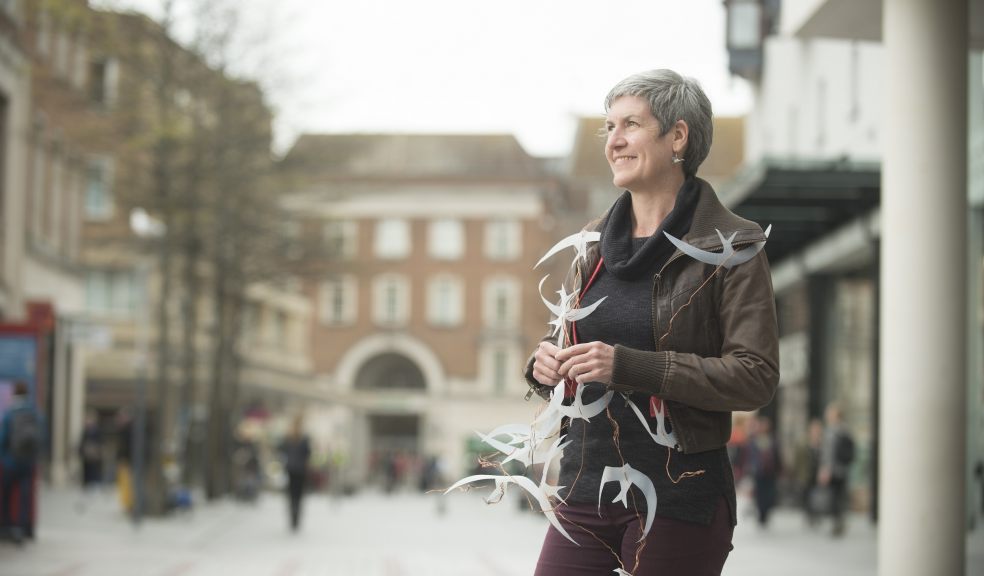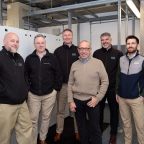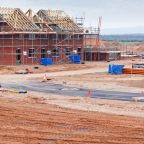
Princesshay announces art installation to mark tenth year
The sky above Princesshay’s Bedford Square is set to be transformed for 8 weeks when a flock of swifts made from recycled plastic bottles take flight as part of a jaw-dropping sculpture commissioned by the centre to celebrate its tenth birthday.
Princesshay has commissioned an exciting art installation sculpture by environmental artist, Naomi Hart, as part of its tenth birthday celebrations. The sculpture will feature thousands of swift birds created by Naomi from recycled plastic bottles, collected from Princesshay stores and restaurants. The swifts will be joined together by copper wire, recycled from old Princesshay electrical cables, giving the illusion of the birds in flight.
The piece will demonstrate how a built environment can help nature to thrive as well as coexist. Swifts, who spend nearly their whole lives flying and even sleep in the air, use buildings to nest in, so everyone can help make space for them and give them a home. The long distance migrants have shared our buildings for over 2,000 years but are now in trouble. The UK lost 39 % of its swifts between 1995 and 2011.
Naomi Hart said; “I am really excited to be working on this project with Princesshay. My work currently focuses on environmental issues as well as a broad theme of ‘migration’ and I feel that this new sculpture will help to capture the aerial display of swifts. It’s great to see that Exeter has already started to help maintain their habitat via the swift tower and I hope that this sculpture will create further awareness of these amazing birds.”
Partnering with the RSPB, Princesshay hopes that the art will have a strong educational message. The RSPB will help with launch day activities, giving visitors the opportunity to learn more about swifts, their habits, behaviors and the way Exeter already supports the birds with nesting boxes and the 26-foot-high Swift Tower, situated on the Paris Street roundabout.
Tony Whitehead, RSPB South West Communications Manager said: “The RSPB is really looking forward to this project, both seeing the realisation of the sculpture and supporting Princesshay to become swift friendly by encouraging the birds to nest on their property. These marvellous birds depend entirely on buildings for nest space in the UK and city centre developments can all do their bit to help reverse the historical declines of this much-loved bird.”
Princesshay’s Centre Director, Wayne Pearce said; “As Princesshay turns 10, we wanted to mark the occasion with something a little different. We hope that the sculpture will encourage shoppers to reflect on the importance of nature and our environment. This feels like a natural extension of the work we are continuing to do in supporting our urban bee population.”
The large scale aerial sculpture, commissioned by Princesshay’s joint owners The Crown Estate and TH Real Estate will be cast over Princesshay Square from the beginning of September this year, marking ten years since the centre opened.
Princesshay supports environmental issues via the City Bee Project which began in 2012. Now home to over 100,000 bees, Princesshay’s tranquil rooftop garden, created for honey bees high above the shopping centre, forms part of the company’s wider biodiversity strategy.
Artist Q&A - Naomi Hart
What led you to focus your work on environmental issues?
I grew up in Kenya and remember snorkelling as a child at the coast. I went back in my early 20's and the coral and fish were all gone. I think that's what galvanised my attention. All that beauty and diversity lost within a generation. I want the next generation to be able to see the incredible natural beauty of the planet and to experience wild nature.
The theme of ‘migration’ runs broadly though your work too?
I think that comes from moving around so much myself! For generations, my family has never stayed put - on both sides they were constantly moving, exploring new countries and opportunities, and when I was young we lived in several different countries, so moving just seems normal. That ties in with my interest in nature as so many birds and animals migrate, too - they know no borders.
Do you always think of a message prior to beginning a piece of work?
No, it's always different. Sometimes a place or material just inspires me to make, sometimes it's words that inspire me. Sometimes the message comes while making it - art is a language, just like any other, and the ideas can come as you are creating.
Tell us about the media you work in please.
Almost anything! I draw and paint, usually in acrylic rather than oil as I work quickly , so it suits my style better. I studied glassblowing and sandcasting as well as sculpture, so I'm happy to work in glass, metal or wood if the opportunity arises. I just love making, and I find it fascinating to be able to make from used or recycled materials - creating something new from what we call rubbish.
How does the art installation you’re making to celebrate Princesshay’s 10th birthday fit in with your wider work?
I'm obsessed with birds - I've made quite a bit of work about them - and I love swifts! It's also fascinating to see Princesshay's recycling yard - a whole underground world - and I'm very keen to support their efforts in recycling but also to make people think about resources and waste.
How did you decide on swifts for the installation?
They are the most amazing creatures. I read Rob Cowen's 'Common Ground' a while ago, which has some beautiful quotes about them.
“You’ll read of the common swift (Apus apus) as a ‘British bird’, but this is something of a misnomer – a bit like saying the passing clouds are British, or the constellations. … Really, we borrow them at best. … The rest of the time they are in transit or … the Democratic Republic of Congo. All the world’s population of common swifts overwinters there, living the same fluid, ranging life under African skies.” (Rob Cowen, 'Common Ground')
“Swifts are almost entirely beings of the air, evolved to spend their lives in a state of permanent airborne motion. … Unless injured, they will never touch the ground. They feed, drink, preen, mate, even sleep in the air.” (Rob Cowen, 'Common Ground')
I also wanted to link the sculpture very much with Exeter, for people to feel how closely we live with nature and how important it is, even in a shopping centre. Exeter has swift boxes for these migrants to nest in when they come to us for the summer. Birds, insects, flowers, trees - we are utterly dependent on nature for our existence and we have to create space in our towns and cities for it.
Can you tell us about the installation itself – how long is the project in the making and how did you decide on materials?
It's been months in the making - with this kind of project my mind is very often working on ideas even when I'm not consciously focusing on it. Walking, watching how birds fly, sketches, doodles and then the long discussions with engineers and working out the technical details. Princesshay showed me their recycling yard and I wanted to use everyday items that we barely think about - the plastic milk bottles are ubiquitous, but we simply throw them away. Electrical cables assist us in almost every area of life, but we never think about where the copper inside comes from (Africa) or what conditions are like there.
What’s been the most challenging aspect to the installation and why?
Working out how to hang the piece - we are essentially hanging from the sky. It's also very large-scale, and it's hard to envisage the space without building it all first.
Your work takes you all over the world – does that make you think a little differently?
I definitely feel the world is incredibly small in some ways and we are all completely connected to each other. I always think about the birds we see here, so tiny, and yet they've flown thousands of miles from Africa, or another part of the world. People move around too, for work, for a better life for their families. We may just move to the next town, or the next country - it's essentially the same thing.
What are the key messages you’d like the Princesshay installation to highlight?
That nature and beauty are all around us, sometimes we just need to take a few minutes out of our day to look up and enjoy it, and that we can all do something right now to make our own environment better for the next generation.
Top Ten Swift Facts
1. Swifts are the most aerial of birds: they feed, drink, preen, sleep, mate and gather nesting material on the wing. They can be continually airborne for 10 months, only landing to nest! And young swifts can be airborne for 3 or 4 years from fledging to when they first nest.
2. Swifts power-nap – scientists tracked migrating swifts flying high to 10,000 feet twice a day, usually at dawn and dusk, giving the birds an opportunity to sleep as they slowly descended.
3. A swift weighs about the same as a Cadbury’s Crème Egg.
4. For its size, the swift has an exceptionally long life-span – averaging 7 years. The oldest recorded common swift was 21.
5. The long life of the common swift means that the accumulated flight distance of a single bird can equal seven round-trip journeys to the moon – more than 3 million miles!
6. Our swifts are only ‘British birds’ for a quarter of their lives (three months per year) – the rest of the time they’re African, wintering in Equatorial and Southern Africa.
7. Swifts use their own spit to glue together a nest made from feathers and vegetation and sited in a crevice high in a wall or roof.
8. Swifts drink by catching raindrops in the air or gliding over smooth water and taking sips.
9. Swifts are monogamous, and the same pairs will breed together in successive years.
10. When baby swifts fledge, they launch themselves off on their very first ever flight - they don’t return to the nest and are no longer cared for by the parents

















